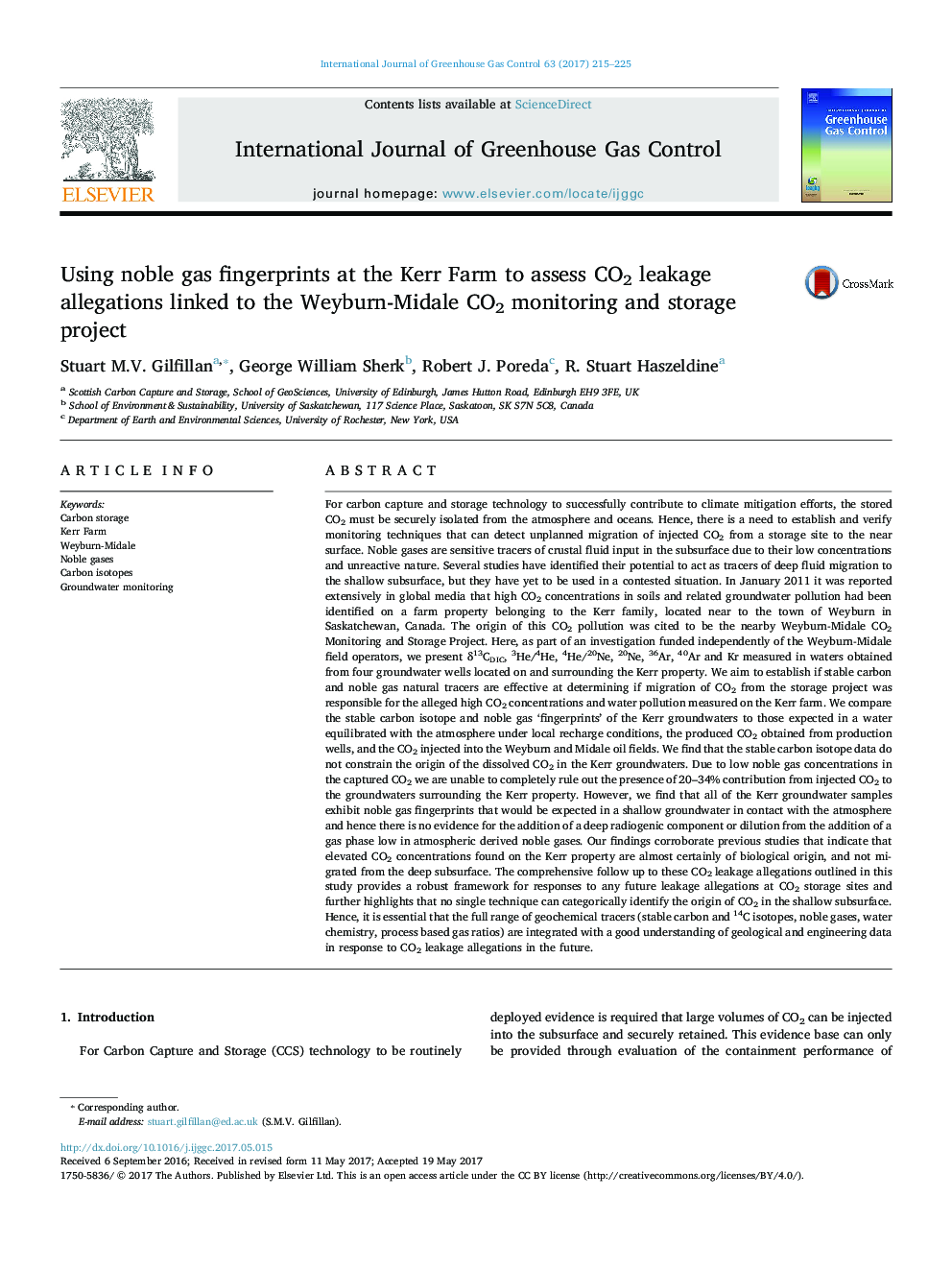| کد مقاله | کد نشریه | سال انتشار | مقاله انگلیسی | نسخه تمام متن |
|---|---|---|---|---|
| 5478833 | 1521956 | 2017 | 11 صفحه PDF | دانلود رایگان |
عنوان انگلیسی مقاله ISI
Using noble gas fingerprints at the Kerr Farm to assess CO2 leakage allegations linked to the Weyburn-Midale CO2 monitoring and storage project
دانلود مقاله + سفارش ترجمه
دانلود مقاله ISI انگلیسی
رایگان برای ایرانیان
کلمات کلیدی
موضوعات مرتبط
مهندسی و علوم پایه
علوم زمین و سیارات
فرآیندهای سطح زمین
پیش نمایش صفحه اول مقاله

چکیده انگلیسی
For carbon capture and storage technology to successfully contribute to climate mitigation efforts, the stored CO2 must be securely isolated from the atmosphere and oceans. Hence, there is a need to establish and verify monitoring techniques that can detect unplanned migration of injected CO2 from a storage site to the near surface. Noble gases are sensitive tracers of crustal fluid input in the subsurface due to their low concentrations and unreactive nature. Several studies have identified their potential to act as tracers of deep fluid migration to the shallow subsurface, but they have yet to be used in a contested situation. In January 2011 it was reported extensively in global media that high CO2 concentrations in soils and related groundwater pollution had been identified on a farm property belonging to the Kerr family, located near to the town of Weyburn in Saskatchewan, Canada. The origin of this CO2 pollution was cited to be the nearby Weyburn-Midale CO2 Monitoring and Storage Project. Here, as part of an investigation funded independently of the Weyburn-Midale field operators, we present δ13CDIC, 3He/4He, 4He/20Ne, 20Ne, 36Ar, 40Ar and Kr measured in waters obtained from four groundwater wells located on and surrounding the Kerr property. We aim to establish if stable carbon and noble gas natural tracers are effective at determining if migration of CO2 from the storage project was responsible for the alleged high CO2 concentrations and water pollution measured on the Kerr farm. We compare the stable carbon isotope and noble gas 'fingerprints' of the Kerr groundwaters to those expected in a water equilibrated with the atmosphere under local recharge conditions, the produced CO2 obtained from production wells, and the CO2 injected into the Weyburn and Midale oil fields. We find that the stable carbon isotope data do not constrain the origin of the dissolved CO2 in the Kerr groundwaters. Due to low noble gas concentrations in the captured CO2 we are unable to completely rule out the presence of 20-34% contribution from injected CO2 to the groundwaters surrounding the Kerr property. However, we find that all of the Kerr groundwater samples exhibit noble gas fingerprints that would be expected in a shallow groundwater in contact with the atmosphere and hence there is no evidence for the addition of a deep radiogenic component or dilution from the addition of a gas phase low in atmospheric derived noble gases. Our findings corroborate previous studies that indicate that elevated CO2 concentrations found on the Kerr property are almost certainly of biological origin, and not migrated from the deep subsurface. The comprehensive follow up to these CO2 leakage allegations outlined in this study provides a robust framework for responses to any future leakage allegations at CO2 storage sites and further highlights that no single technique can categorically identify the origin of CO2 in the shallow subsurface. Hence, it is essential that the full range of geochemical tracers (stable carbon and 14C isotopes, noble gases, water chemistry, process based gas ratios) are integrated with a good understanding of geological and engineering data in response to CO2 leakage allegations in the future.
ناشر
Database: Elsevier - ScienceDirect (ساینس دایرکت)
Journal: International Journal of Greenhouse Gas Control - Volume 63, August 2017, Pages 215-225
Journal: International Journal of Greenhouse Gas Control - Volume 63, August 2017, Pages 215-225
نویسندگان
Stuart M.V. Gilfillan, George William Sherk, Robert J. Poreda, R. Stuart Haszeldine,